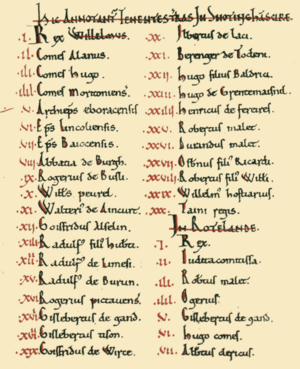Nottinghamshire Domesday Book tenants-in-chief facts for kids
Imagine a super old record book from over 900 years ago! That's kind of what the Domesday Book is. It was made in 1086 AD by order of King William the Conqueror after he took over England in 1066. This book listed all the land and who owned it across England, including a place called Snotinghscire (which we now call Nottinghamshire).
The people listed here were the most important landowners, called tenants-in-chief. They held their land directly from the King. Let's meet some of these powerful figures from ancient Nottinghamshire!
Contents
- Who Were Nottinghamshire's Top Landowners?
- The King and His Family
- Important Nobles and Knights
- Count Alan of Brittany
- Earl Hugh of Chester
- Roger de Busli
- William Peverel
- Walter D'Aincourt
- Ralph son of Hubert (FitzHubert)
- Roger de Poitou
- Gilbert de Gant
- Gilbert Tison
- Geoffrey de la Guerche
- Ilbert de Lacy
- Berengar de Tosny
- Hugh fitzBaldrick
- Hugh de Grandmesnil
- Henry de Ferrers
- Robert Malet
- Osbern fitzRichard
- Religious Leaders and Institutions
- Other Important People
- See also
Who Were Nottinghamshire's Top Landowners?
The Domesday Book lists many important people who held land directly from King William in Nottinghamshire. These were the most powerful people in the area.
The King and His Family
King William the Conqueror
King William (born around 1028, died 1087) was the very first Norman King of England. He became king after winning the Battle of Hastings in 1066. Before that, he was the Duke of Normandy. As the King, he was the ultimate owner of all land.
Count Robert of Mortain
Count Robert (born around 1031, died around 1095) was King William the Conqueror's half-brother. He fought bravely at the Battle of Hastings. He became the 2nd Earl of Cornwall and was one of the biggest landowners in all of England. You can even see him sitting next to King William on the famous Bayeux Tapestry.
Robert Curthose
Robert Curthose (born around 1051, died 1134) was King William the Conqueror's son. After his father died in 1087, Robert became the Duke of Normandy.
Important Nobles and Knights
Count Alan of Brittany
Count Alan (born around 1040, died 1093) was also known as Alan Rufus or Alan the Red. He was given a lot of land in England, which later became known as the Honour of Richmond.
Earl Hugh of Chester
Earl Hugh (born around 1047, died 1101) helped King William by providing 60 ships for the invasion of England. However, he didn't actually fight in the Battle of Hastings himself.
Roger de Busli
Roger de Busli (born around 1038, died around 1099) was a very important landowner. He was granted 86 manors (large estates) just in Nottinghamshire! He also owned land in Yorkshire, Derbyshire, Lincolnshire, Leicestershire, and Devon. His lands became known as the Honour of Blyth.
William Peverel
William Peverel (born around 1040, died around 1115) was given over a hundred manors in central England by the King. These lands formed the Honour of Peverel, which included important places like Nottingham Castle. He also built Peveril Castle in Derbyshire.
Walter D'Aincourt
Walter D'Aincourt was connected to William the Conqueror through marriage. Because of this, he was given over 70 manors in the East Midlands and Yorkshire.
Ralph son of Hubert (FitzHubert)
Ralph FitzHubert (born 1045, died 1086) was the son of Hubert de Corcun.
Roger de Poitou
Roger de Poitou's father, Roger de Montgomery, was one of King William the Conqueror's main advisors.
Gilbert de Gant
Gilbert de Gant (born around 1048, died 1095) was related to King William the Conqueror's wife.
Gilbert Tison
Gilbert Tison's lands were later taken back by the King around 1118. They were then given to other important families.
Geoffrey de la Guerche
Geoffrey de la Guerche (born around 1040, died around 1094) came from a noble family near Rennes, on the border of Brittany and Anjou.
Ilbert de Lacy
Ilbert de Lacy and his brother Walter came from Normandy with William the Conqueror. The King rewarded them both with land. Ilbert's main lands were in west Yorkshire.
Berengar de Tosny
Berengar de Tosny (born around 1050) was the eldest son of Robert de Tosny, who founded Belvoir Priory.
Hugh fitzBaldrick
Hugh fitzBaldrick was the High Sheriff of Yorkshire from 1069 to about 1080. He gave some of his English lands to religious places in Normandy and York.
Hugh de Grandmesnil
Hugh de Grandmesnil (born 1032, died 1098) fought in the Battle of Hastings. For his service, he was given 100 manors, mostly in Leicestershire. He was also made the High Sheriff of Leicestershire and Governor of Hampshire.
Henry de Ferrers
Henry de Ferrers worked for King William the Conqueror and his son, King William II, in important administrative jobs.
Robert Malet
Robert Malet (born around 1050, died in the 1100s) was the son of William Malet. He was the High Sheriff of Norfolk and Suffolk from 1070 to 1080. He was a close advisor to King Henry I and owned over 200 manors in Suffolk.
Osbern fitzRichard
Osbern fitzRichard was the son of Richard Scrob, who founded Richard's Castle in Herefordshire.
Religious Leaders and Institutions
- Archbishop of York
- Bishop of Lincoln
- Bishop of Bayeux
- Abbey of Burgh
Other Important People
- Geoffrey Alselin
- Ralph de Limésy
- Ralph de Buron
- Durand Malet
- William the Usher
- King's Thanes (These were important landholders who served the King before the Norman Conquest.)
See also


